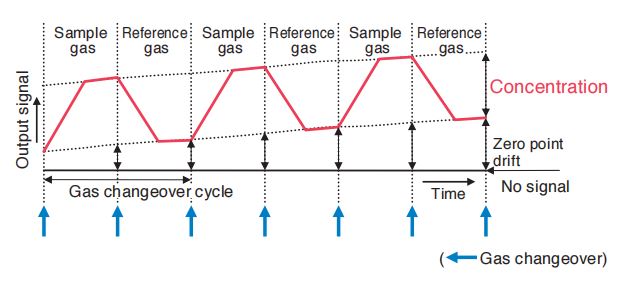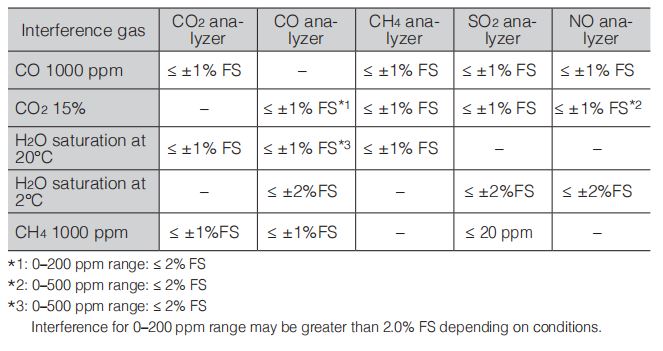What is a gas analyzer?
A gas analyzer is a scientific instrument designed to measure and analyze the composition of gases in a given sample. These devices are essential in various fields, including environmental monitoring, industrial processes, healthcare, and research.
Gas analyzers are widely used in both industry and research for various purposes, including continuous emission and process monitoring. They are useful in analyzing gas composition and detecting impurities to optimize production processes. Gas analyzers are also used to monitor hazardous trace gases in the air to ensure workplace safety or measure greenhouse gases that affect the climate.
The role of these equipment is to evaluate whether a gas composition meets specifications or whether impurities are present in the ppb or even ppt range. The instruments are designed as extractive measurement systems and guarantee excellent measurement quality.
We are able to offer solutions for hazardous locations via explosion proof housing design, or indoor and outdoor areas.
Types of Gas Analyzers
Gas analyzers help to understand the presence and concentration of different gases in a mixture, which is crucial for safety, quality control, and regulatory compliance purposes. There are various types of gas analyzers, each tailored to specific applications and capable of measuring different types of gases.
NDIR Gas Analyzer ZPA ZPB ZPG

Features of NDIR Gas Analyzer ZPA ZPB ZPG
The NDIR Gas Analyzer Series boasts exceptional sensitivity and stability, providing accurate and consistent measurements over extended periods. These analyzers ensure peace of mind with their ±0.5% FS per week zero-point stability (ZPB, ZPG).
The ZPG model is equipped to handle low-range measurements, detecting gas concentrations as low as 0–5 ppm. This high sensitivity makes it ideal for applications where even minute gas levels are critical.
The ZPA and ZPB models offer the unique capability of continuous and simultaneous measurement of up to five components. These analyzers are versatile tools, suitable for complex gas mixture analysis.
NDIR gas analyzers utilize an innovative sample-switching method, employing a motor-operated valve to switch between the sample gas and the reference gas (zero gas) at regular intervals. This ensures precise zero-point accuracy and delivers stable measurements.

Interference from moisture and other gases is reduced by the compensation function and the sample switching method (ZPB and ZPG):

Each analyzer is equipped with a user-friendly LCD display for effortless operation and clear visualization of measurement data. The intuitive interface allows for easy configuration and real-time monitoring.
ZPAF Biomass Gas Analyzer

The ZPAF Biomass Gas Analyzer is a compact and lightweight gas analyzer that measures H2S, CH4, CO2, and O2 generated in biogas plants. It is designed to be used in a variety of applications, including:
- Biogas production: The ZPAF can be used to monitor the quality of biogas, ensuring that it meets the required specifications for use as a fuel or for other applications.
- Safety: The ZPAF can be used to detect and measure the concentration of hazardous gases, such as H2S and CO, in biogas plants. This helps to ensure the safety of workers and the environment.
- Process control: The ZPAF can be used to monitor the concentration of gases in biogas plants, helping to ensure that the process is operating efficiently.
The ZPAF is a versatile and reliable gas analyzer that can be used to improve the safety, quality, and efficiency of biogas plants.
Features of ZPAF Biogas Analyzer
Here are some of the key features of the ZPAF Biomass Gas Analyzer:
- Simultaneous and continuous measurement of H2S, CH4, CO2, and O2
- Compact and lightweight design
- Easy-to-use LCD display
- Optional functions include automatic calibration, concentration alarm, remote input for switching range, and more
If you are looking for a reliable and versatile gas analyzer for your biogas plant, the ZPAF is a great option.
Laser Gas Analyzer ZSS

The Laser Gas Analyzer ZSS is a cross-stack laser gas analyzer manufactured by Fuji Electric. It is designed to measure the concentration of HCl, NH3, CO, CO2, CH4, and O2 in flue gases. The ZSS is a non-dispersive infrared (NDIR) gas analyzer, which means that it uses infrared light to measure the concentration of gases.
Laser Gas Analyzer ZSS Applications
The ZSS has a number of advantages over other gas analyzers, including:
- Fast response time: The ZSS can measure the concentration of gases in a matter of seconds, making it ideal for applications where rapid response is required.
- High accuracy: The ZSS is highly accurate, with a typical accuracy of ±1% FS.
- Low maintenance: The ZSS requires very little maintenance, making it a cost-effective solution for long-term monitoring.
- Robust design: The ZSS is a rugged and reliable instrument that is designed to withstand harsh environmental conditions.
The ZSS is used in a variety of applications, including:
- Environmental monitoring: The ZSS can be used to monitor the concentration of gases in flue gases from power plants, industrial boilers, and other combustion sources.
- Process control: The ZSS can be used to monitor the concentration of gases in industrial processes, such as chemical reactions and waste treatment.
- Safety: The ZSS can be used to detect and measure the concentration of hazardous gases, such as CO and H2S.
The ZSS is a versatile and reliable gas analyzer that can be used to improve the safety, quality, and efficiency of a variety of processes.
ZFK8 Detector and ZFKE Converter

Features of ZFK8 Detector
The ZFK8 Detector is a direct insertion type zirconia oxygen sensor manufactured by Fuji Electric. It is designed to measure the concentration of oxygen in combustion exhaust gas of industrial boilers or furnaces. The ZFK8 Detector is a rugged and reliable instrument that is easy to use and maintain.
Here are some of the key features of the ZFK8 Detector:
- Direct insertion design: The ZFK8 Detector is inserted directly into the gas stream, which eliminates the need for a gas sampling system. This makes the ZFK8 Detector a simple and cost-effective solution for oxygen monitoring.
- Zirconium oxide sensor: The ZFK8 Detector uses a zirconium oxide sensor, which is a highly accurate and reliable sensor for measuring oxygen.
- Easy to use: The ZFK8 Detector is easy to use and maintain. The sensor can be replaced quickly and easily, and the analyzer does not require any special calibration.
- Rugged design: The ZFK8 Detector is a rugged and reliable instrument that is designed to withstand harsh environmental conditions.
Applications of ZFK8 Detector
The ZFK8 Detector is used in a variety of applications, including:
- Combustion management: The ZFK8 Detector can be used to monitor the combustion efficiency of boilers and furnaces. This helps to ensure that the boilers and furnaces are operating at their optimum efficiency, which can save energy and money.
- Emissions control: The ZFK8 Detector can be used to monitor the emissions of boilers and furnaces. This helps to ensure that the boilers and furnaces are meeting emissions regulations.
- Safety: The ZFK8 Detector can be used to detect and measure the concentration of oxygen in combustion exhaust gas. This helps to ensure that the oxygen concentration in the gas is safe for workers and the environment.
The ZFK8 Detector is a versatile and reliable instrument that can be used to improve the safety, efficiency, and environmental compliance of a variety of processes.
Features of ZFKE Converter
The ZFKE converter is a device that is used to interface the ZFK8 detector with a variety of control systems. The ZFKE converter converts the analog output signal from the ZFK8 detector into a digital signal that can be understood by the control system. The ZFKE converter also provides a number of other features, such as alarm output, remote control, and data logging.
Here are some of the key features of the ZFKE converter:
- Interfaces with a variety of control systems: The ZFKE converter can interface with a variety of control systems, including Modbus RTU, Profibus DP, and DeviceNet.
- Converts analog signal to digital signal: The ZFKE converter converts the analog output signal from the ZFK8 detector into a digital signal that can be understood by the control system.
- Provides alarm output: The ZFKE converter can provide alarm output when the oxygen concentration in the gas exceeds a pre-set level.
- Remote control: The ZFKE converter can be remotely controlled using a variety of methods, including RS-485, Ethernet, and USB.
- Data logging: The ZFKE converter can log data from the ZFK8 detector, such as the oxygen concentration in the gas, the temperature of the gas, and the pressure of the gas.
The ZFKE converter is a versatile and reliable device that can be used to improve the safety, efficiency, and environmental compliance of a variety of processes.

